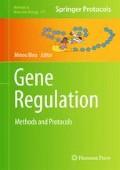Abstract
Estrogens, acting via estrogen receptor (ER) play key roles in growth, differentiation, and gene regulation in the reproductive, central nervous, and skeletal systems. ER-mediated gene transcription contributes to the development and spread of breast, uterine, and liver cancer. Steroid receptor coactivator-1a (SRC1a) belongs to the P160 family of coactivators, which is the best known of the many coactivators implicated in ER-mediated transactivation. Binding of full-length P160 coactivators to steroid receptors has been difficult to investigate in vitro. This chapter details how to investigate the interaction of SRC1a with ER using the fluorescence anisotropy/polarization microplate assay (FAMA).
Access this chapter
Tax calculation will be finalised at checkout
Purchases are for personal use only
References
Luconi M, Forti G, Baldi E (2002) Genomic and nongenomic effects of estrogens: molecular mechanisms of action and clinical implications for male reproduction. J Steroid Biochem Mol Biol 80:369–381
Katzenellenbogen BS, Katzenellenbogen JA (2000) Estrogen receptor transcription and transactivation: estrogen receptor alpha and estrogen receptor beta: regulation by selective estrogen receptor modulators and importance in breast cancer. Breast Cancer Res 2:335–344
Tsai MJ, O’Malley BW (1994) Molecular mechanisms of action of steroid/thyroid receptor superfamily members. Annu Rev Biochem 63:451–486
Evans RM (1988) The steroid and thyroid hormone receptor superfamily. Science 240: 889–895
Mosselman S, Polman J, Dijkema R (1996) ER beta: identification and characterization of a novel human estrogen receptor. FEBS Lett 392:49–53
Carroll JS, Brown M (2006) Estrogen receptor target gene: an evolving concept. Mol Endocrinol 20:1707–1714
Carroll JS, Liu XS, Brodsky AS, Li W, Meyer CA, Szary AJ, Eeckhoute J, Shao W, Hestermann EV, Geistlinger TR, Fox EA, Silver PA, Brown M (2005) Chromosome-wide mapping of estrogen receptor binding reveals long-range regulation requiring the forkhead protein FoxA1. Cell 122:33–43
O’Lone R, Frith MC, Karlsson EK, Hansen U (2004) Genomic targets of nuclear estrogen receptors. Mol Endocrinol 18:1859–1875
Klinge CM, Jernigan SC, Smith SL, Tyulmenkov VV, Kulakosky PC (2001) Estrogen response element sequence impacts the conformation and transcriptional activity of estrogen receptor alpha. Mol Cell Endocrinol 174:151–166
Krieg SA, Krieg AJ, Shapiro DJ (2001) A unique downstream estrogen responsive unit mediates estrogen induction of proteinase inhibitor-9, a cellular inhibitor of IL-1beta- converting enzyme (caspase 1). Mol Endocrinol 15:1971–1982
Glass CK, Rosenfeld MG (2000) The coregulator exchange in transcriptional functions of nuclear receptors. Genes Dev 14:121–141
Xu J, O’Malley BW (2002) Molecular mechanisms and cellular biology of the steroid receptor coactivator (SRC) family in steroid receptor function. Rev Endocr Metab Disord 3:185–192
Spiegelman BM, Heinrich R (2004) Biological control through regulated transcriptional coactivators. Cell 119:157–167
Kalkhoven E, Valentine JE, Heery DM, Parker MG (1998) Isoforms of steroid receptor co-activator 1 differ in their ability to potentiate transcription by the oestrogen receptor. EMBO J 17:232–243
Wang SY, Ahn BS, Harris R, Nordeen SK, Shapiro DJ (2004) Fluorescence anisotropy microplate assay for analysis of steroid receptor-DNA interactions. Biotechniques 37:807-8, 810-7
Wang S, Zhang C, Nordeen SK, Shapiro DJ (2007) In vitro fluorescence anisotropy analysis of the interaction of full-length SRC1a with estrogen receptors alpha and beta supports an active displacement model for coregulator utilization. J Biol Chem 282:2765–2775
Mao C, Patterson NM, Cherian MT, Aninye IO, Zhang C, Montoya JB, Cheng J, Putt KS, Hergenrother PJ, Wilson EM, Nardulli AM, Nordeen SK, Shapiro DJ (2008) A new small molecule inhibitor of estrogen receptor alpha binding to estrogen response elements blocks estrogen-dependent growth of cancer cells. J Biol Chem 283:12819–12830
Kretzer NM, Cherian MT, Mao CJ, Aninye IO, Reynolds PD, Schiff R, Hergenrother PJ, Nordeen SK, Wilson EM, Shapiro DJ (2010) A noncompetitive small molecule inhibitor of estrogen-regulated gene expression and breast cancer cell growth that enhances proteasome-dependent degradation of estrogen receptor alpha. J Biol Chem 285:41863–41873
Shapiro DJ, Mao CJ, Cherian MT (2011) Small molecule inhibitors as probes for estrogen and androgen receptor action. J Biol Chem 286:4043–4048
Zhang CC, Krieg S, Shapiro DJ (1999) HMG-1 stimulates estrogen response element binding by estrogen receptor from stably transfected HeLa cells. Mol Endocrinol 13:632–643
Thackray VG, Nordeen SK (2002) High-yield purification of functional, full-length steroid receptor coactivator 1 expressed in insect cells. Biotechniques 32(260):262–263
Bramlett KS, Wu Y, Burris TP (2001) Ligands specify coactivator nuclear receptor (NR) box affinity for estrogen receptor subtypes. Mol Endocrinol 15:909–922
Author information
Authors and Affiliations
Editor information
Editors and Affiliations
Rights and permissions
Copyright information
© 2013 Springer Science+Business Media, LLC
About this protocol
Cite this protocol
Zhang, C., Nordeen, S.K., Shapiro, D.J. (2013). Fluorescence Anisotropy Microplate Assay to Investigate the Interaction of Full-Length Steroid Receptor Coactivator-1a with Steroid Receptors. In: Bina, M. (eds) Gene Regulation. Methods in Molecular Biology, vol 977. Humana Press, Totowa, NJ. https://doi.org/10.1007/978-1-62703-284-1_27
Download citation
DOI: https://doi.org/10.1007/978-1-62703-284-1_27
Published:
Publisher Name: Humana Press, Totowa, NJ
Print ISBN: 978-1-62703-283-4
Online ISBN: 978-1-62703-284-1
eBook Packages: Springer Protocols

